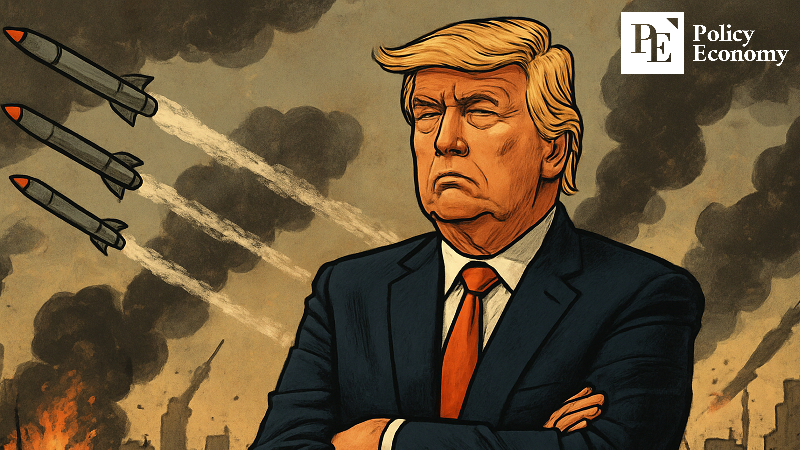“Airstrikes Continue Day and Night” — Escalating Crisis Toward Full-Scale War Between Israel and Iran
Input
Modified
Escalation of Military Clashes Between Israel and Iran Is Israel Aiming for the Collapse of the Iranian Regime? U.S. and Russia Call for Mediation but Refrain from Direct Involvement

The long-simmering hostility between Israel and Iran has erupted into open warfare. What was once confined to covert operations and proxy conflicts has become a dramatic and sustained military confrontation. In the span of just a few days, a dangerous rhythm of tit-for-tat missile strikes, and air raids has taken hold. Civilian neighborhoods, government buildings, and strategic facilities lie in ruins. Both nations are bracing for escalation, and the threat of a full-scale regional war looms large. Amid the chaos, major global powers—those with the leverage to mediate—stand largely on the sidelines, issuing calls for calm while avoiding direct involvement.
The latest outbreak of violence signals more than a clash of national interests. It marks a shift in the region’s balance of power, testing the resolve of governments, the resilience of populations, and the limits of diplomacy. As casualties mount and cities burn, the world watches the unfolding disaster with growing anxiety.
Clashes Intensify as Cities Become Warzones
On June 15, the Iranian capital of Tehran was the scene of a dramatic escalation. Around midday, explosions shattered the relative calm near Valiasr Square in the heart of the city. Just hours later, a series of blasts rocked northern Tehran. Iranian media swiftly confirmed that Israeli airstrikes had targeted buildings connected to the city’s police headquarters and intelligence agencies. The strikes marked a significant escalation in Israel’s campaign and struck close to key symbols of Iranian state power.
Within an hour of the initial attacks, Iran launched an unprecedented daylight missile offensive on Israeli cities. The IRNA, Iran’s state-run news agency, announced that major population centers including Tel Aviv, Ashkelon, and Haifa were under direct missile fire. This marked the first time Iran had carried out such an attack in broad daylight, signaling a bold departure from its typical after-dark tactics and a shift in strategic posture.
The exchange of fire continued into the night. Iran’s Islamic Revolutionary Guard Corps (IRGC) announced additional missile salvos targeting Israel and issued stern warnings to Israeli citizens via national broadcasts to avoid vital infrastructure. Eyewitness reports from AFP and Reuters described sirens blaring and explosions rocking areas across Tel Aviv and Jerusalem. Iran’s semi-official Tasnim News Agency reported that Ben Gurion International Airport—Israel’s primary international hub—had been hit by missiles. The attack was interpreted as retaliation for Israel’s earlier strike on Iran’s Mashhad Airport.
As Iranian missiles rained down, Israel launched a series of precision counterattacks. Dozens of missile-related facilities in western Iran were bombarded. Notably, the Iranian Ministry of Foreign Affairs building sustained damage. Iranian Deputy Foreign Minister Saeed Khatibzadeh, writing on X (formerly Twitter), condemned what he described as a deliberate attack on diplomatic institutions and revealed that numerous civilians and diplomats had been wounded.
The human toll of this escalating crisis continues to rise. Israeli relief authorities reported at least 13 dead and 380 injured over three days of attacks. Iranian health officials announced 224 fatalities, while U.S. human rights organizations, cited by the Associated Press, put the death toll at 406. The conflict’s reach has extended beyond national borders. Ukraine’s Ministry of Foreign Affairs confirmed that five Ukrainian nationals, including three children, were killed during an Israeli airstrike on the southern city of Bat Yam.
Operation Rising Lion: A Strike on Iran’s Nuclear Heart
The spark that ignited this deadly spiral was lit on June 13, when Israel initiated a preemptive airstrike campaign targeting Iran’s nuclear and military infrastructure. Codenamed “Operation Rising Lion,” the assault involved dozens of fighter jets striking key Iranian targets. According to Israeli Prime Minister Benjamin Netanyahu, the mission was intended to halt what he described as an existential threat posed by Iran’s advancing nuclear program.
In public remarks, Netanyahu declared, “We have launched Operation Rising Lion to repel Iran, which threatens Israel’s survival.” He revealed that the strikes had hit the heart of Iran’s uranium enrichment program, as well as missile production sites and military command centers. He went further, stating that Iran had accumulated enough highly enriched uranium for nine nuclear bombs, and could achieve weaponization within months.
Netanyahu's rhetoric was intense and deeply symbolic. Drawing a line between past and present, he evoked the trauma of the Holocaust: “Eighty years ago, Jews were victims of the Nazi regime. Today, the Jewish state of Israel refuses to become a victim of a nuclear holocaust brought on by the Iranian regime.”
The decision to escalate militarily followed months of deadlocked nuclear negotiations between the United States and Iran. Since April, the Trump administration has engaged in five rounds of talks, but they have failed to produce results. The central impasse revolves around uranium enrichment. The U.S. has insisted on a complete ban, while Iran remains firm that a total prohibition is unacceptable. The sixth round of negotiations, scheduled for June 15, was abruptly canceled in the aftermath of Israel’s initial strike.
Israel’s sense of urgency stems not only from diplomatic failure but also from a strategic assessment that time is running out. The fear is that if Iran’s nuclear progress is left unchecked, it will irreversibly shift the regional power dynamic, posing an intolerable risk to Israeli national security.

Calculating Collapse: Is Regime Change the Real Goal?
Beyond the immediate military objectives, some analysts argue that Israel’s true aim may be to trigger the downfall of the Iranian regime itself. With public dissent in Iran rising and internal fractures widening, the current moment presents a unique opportunity—at least from the perspective of Israeli strategists.
On June 15, in an interview with Fox News, Prime Minister Netanyahu openly hinted at this possibility. “The Iranian regime is very weak,” he said, “and there is a possibility that our military attacks could lead to regime change.” The comment has only intensified speculation that toppling the government in Tehran may be a central, if unofficial, goal of Operation Rising Lion.
The Iranian regime has been rocked by internal unrest, with protests erupting across the country over mandatory hijab laws, as well as broader grievances involving youth, gender rights, and ethnic minority discrimination. If the economic toll of war continues to grow, public outrage could intensify, potentially mobilizing broader calls for regime change.
There are also fears that Israel could escalate its campaign into a “decapitation operation”—a strategy focused on surgically removing top regime figures. Such a move could induce administrative paralysis, throwing the government into disarray and hastening its collapse.
This agenda may be quietly supported by major powers. Both the United States and Russia—nations with vested interests in the regional order—have expressed concern over the conflict but have stopped short of intervention. Instead, they remain in observation mode. Before departing for the G7 summit in Canada, U.S. President Donald Trump remarked, “I hope a ceasefire agreement between Israel and Iran can be reached, and I believe the time has come to negotiate,” before adding, “Sometimes nations need to fight it out first.” When asked if he had urged Israel to halt its airstrikes, Trump deflected: “I don’t want to comment on that.”
Meanwhile, Russian President Vladimir Putin has attempted to play the role of mediator, speaking by phone with both Netanyahu and Iranian leadership following the outbreak of violence. Yet despite his diplomatic gestures, Putin has provided no material support or substantive mediation effort, signaling a broader reluctance by global powers to entangle themselves directly in the conflict.
The situation between Israel and Iran has now crossed a threshold. It is no longer a matter of brinkmanship—it is a sustained and brutal conflict with global implications. The stakes have escalated beyond missile exchanges and nuclear inspections. At issue now is the stability of the Middle East, the future of nuclear nonproliferation, and possibly, the survival of a regime in Tehran. While the world watches, and while statements are made from podiums thousands of miles away, the violence on the ground continues day and night.




















